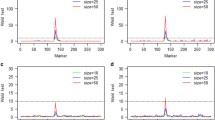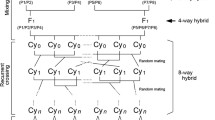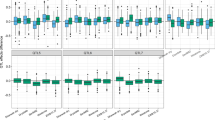Abstract
High-density genotyping is extensively exploited in genome-wide association mapping studies and genomic selection in maize. By contrast, linkage mapping studies were until now mostly based on low-density genetic maps and theoretical results suggested this to be sufficient. This raises the question, if an increase in marker density would be an overkill for linkage mapping in biparental populations, or if important QTL mapping parameters would benefit from it. In this study, we addressed this question using experimental data and a simulation based on linkage maps with marker densities of 1, 2, and 5 cM. QTL mapping was performed for six diverse traits in a biparental population with 204 doubled haploid maize lines and in a simulation study with varying QTL effects and closely linked QTL for different population sizes. Our results showed that high-density maps neither improved the QTL detection power nor the predictive power for the proportion of explained genotypic variance. By contrast, the precision of QTL localization, the precision of effect estimates of detected QTL, especially for small and medium sized QTL, as well as the power to resolve closely linked QTL profited from an increase in marker density from 5 to 1 cM. In conclusion, the higher costs for high-density genotyping are compensated for by more precise estimates of parameters relevant for knowledge-based breeding, thus making an increase in marker density for linkage mapping attractive.



Similar content being viewed by others
References
Ali ML, Taylor JH, Jie L et al (2005) Molecular mapping of QTLs for resistance to Gibberella ear rot, in corn, caused by Fusarium graminearum. Genome 48:521–533
Almeida GD, Makumbi D, Magorokosho C et al (2012) QTL mapping in three tropical maize populations reveals a set of constitutive and adaptive genomic regions for drought tolerance. Theor Appl Genet 126:583–600
Baierl A, Bogdan M, Frommlet F, Futschik A (2006) On locating multiple interacting quantitative trait loci in intercross designs. Genetics 173:1693–1703
Bolduan C, Miedaner T, Schipprack W et al (2009a) Genetic variation for resistance to ear rots and mycotoxins contamination in early European maize inbred lines. Crop Sci 49:2019–2028
Bolduan C, Montes JM, Dhillon BS et al (2009b) Determination of mycotoxin concentration by ELISA and near-infrared spectroscopy in Fusarium-inoculated maize. Maize Cereal Res Commun 37:521–529
Buckler ES, Holland JB, Bradbury PJ et al (2009) The genetic architecture of maize flowering time. Science 325:714–718
Churchill GA, Doerge RW (1994) Empirical threshold values for quantitative trait mapping. Genetics 138:963–971
Darvasi A, Weinreb A, Minke V et al (1993) Detecting marker-QTL linkage and estimating QTL gene effect and map location using a saturated genetic map. Genetics 134:943–951
Doerge RW (2002) Mapping and analysis of quantitative trait loci in experimental populations. Nat Rev Genet 3:43–52
Falconer DS, Mackay TFC (1996) Introduction to quantitative genetics, 4th edn. Longmans Green, Harlow
Frisch M, Bohn M, Melchinger AE (2000) Plabsim: software for simulation of marker-assisted backcrossing. J Hered 91:86–87
Guo J, Chen Z, Liu Z et al (2011) Identification of genetic factors affecting plant density response through QTL mapping of yield component traits in maize (Zea mays L.). Euphytica 182:409–422
Haley CS, Knott SA (1992) A simple regression method for mapping quantitative trait loci in line crosses using flanking markers. Heredity 69:315–324
Hallauer AR, Carena MJ, Miranda JB (2010) Quantitative genetics in maize breeding. Iowa State University Press, Ames
Hori K, Kobayashi T, Shimizu A et al (2003) Efficient construction of high-density linkage map and its application to QTL analysis in barley. Theor Appl Genet 107:806–813
Lawrence CJ, Harper LC, Schaeffer ML et al (2008) MaizeGDB: the maize model organism database for basic, translational, and applied research. Int J Plant Genom 2008:496957
Li H, Hearne S, Bänziger M et al (2010) Statistical properties of QTL linkage mapping in biparental genetic populations. Heredity 105:257–267
Liu W, Reif JC, Ranc N et al (2012) Comparison of biometrical approaches for QTL detection in multiple segregating families. Theor Appl Genet 125:987–998
Ma XQ, Tang JH, Teng WT et al (2007) Epistatic interaction is an important genetic basis of grain yield and its components in maize. Mol Breed 20:41–51
Martin M, Miedaner T, Dhillon BS et al (2011) Colocalization of QTL for Gibberella ear rot resistance and low mycotoxin contamination in early European maize. Crop Sci 51:1935–1945
Martin M, Miedaner T, Schwegler DD et al (2012) Comparative quantitative trait loci mapping for Gibberella ear rot resistance and reduced deoxynivalenol contamination across connected maize populations. Crop Sci 52:32–43
Pestka JJ (2007) Deoxynivalenol: toxicity, mechanisms and animal health risks. Anim Feed Sci Tech 137:283–298
Piepho HP (2000) Optimal marker density for interval mapping in a backcross population. Heredity 84:437–440
Prigge V, Melchinger AE (2012) Production of haploids and doubled haploids in maize. Methods Mol Biol 877:161–172
Prigge V, Xu X, Li L et al (2012) New insights into the genetics of in vivo induction of maternal haploids, the backbone of doubled haploid technology in maize. Genetics 190:781–793
Riedelsheimer C, Lisea J, Czedik-Eysenberg A et al (2012a) Genome-wide association mapping of leaf metabolic profiles for dissecting complex traits in maize. Proc Natl Acad Sci USA 109:8872–8877
Riedelsheimer C, Technow F, Melchinger AE (2012b) Comparison of whole-genome prediction models for traits with contrasting genetic architecture in a diversity panel of maize inbred lines. BMC Genomics 13:452
Schaeffer M, Byrne P, EHC J et al (2006) Consensus quantitative trait maps in maize: a database strategy. Maydica 51:357–367
Shi L, Hao Z, Weng J et al (2011) Identification of a major quantitative trait locus for resistance to maize rough dwarf virus in a Chinese maize inbred line X178 using a linkage map based on 514 gene-derived single nucleotide polymorphisms. Mol Breed 30:615–625
Stange M, Schrag TA, Utz HF, Riedelsheimer C, Bauer E, Melchinger AE (2013) High-density linkage mapping of yield and epistatic interactions in maize with doubled hapoid lines from four crosses. Mol Breed. doi:10.1007/s11032-013-9887-z
Utz HF (2005) PLABSTAT—a computer program for statistical analysis of plant breeding experiments, 3A. Universität Hohenheim, Germany
Utz HF (2012) PlabMQTL—Software for meta-QTL analysis with composite interval mapping. Version 0.5s. Institute of Plant Breeding, Seed Science, and Population Genetics, University of Hohenheim. PlabMQTL Manual
Utz HF, Melchinger AE, Schön CC (2000) Bias and sampling error of the estimated proportion of genotypic variance explained by quantitative trait loci determined from experimental data in maize using cross validation and validation with independent samples. Genetics 154:1839–1849
Van Ooijen JW (2006) JoinMap® 4, Software for the calculation of genetic linkage maps in experimental populations. Kyazma BV, Wageningen
Wu Y, Bhat PR, Close TJ, Lonardi S (2008) Efficient and accurate construction of genetic linkage maps from the minimum spanning tree of a graph. PLoS Genet 4:e1000212
Würschum T (2012) Mapping QTL for agronomic traits in breeding populations. Theor Appl Genet 125:201–210
Yan J, Yang X, Shah T et al (2009) High-throughput SNP genotyping with the GoldenGate assay in maize. Mol Breed 25:441–451
Yu H, Xie W, Wang J et al (2011) Gains in QTL detection using an ultra-high density SNP map based on population sequencing relative to traditional RFLP/SSR markers. PloS One 6:e17595
Acknowledgments
This research was financed by the Deutsche Forschungsgemeinschaft (DFG) research grant ME 2260/6-1 and supported by funds from DFG (Grant No. 1070, International Research Training Group “Sustainable Resource Use in North China”) to M. Stange and Albrecht E. Melchinger. Part of the SNP analysis of this research was supported by the project “Cornfed” by the French National Agency for Research (ANR), the German Federal Ministry of Education and Research (BMBF), and the Spanish Ministry of Science and Innovation (MICINN). Part of this research was conducted in collaboration between the University of Hohenheim and CYMMIT under the Federal Ministry for Economic Cooperation and Development (BMZ) founded project “Abiotic stress tolerant maize for increasing income and food security among the poor in South and Southeast Asia”.
Conflict of interest
The authors declare that they have no conflict of interest.
Ethical standard
The experiments performed within this study comply with the current laws of Germany.
Author information
Authors and Affiliations
Corresponding author
Additional information
Communicated by J. Yan.
Electronic supplementary material
Below is the link to the electronic supplementary material.
Rights and permissions
About this article
Cite this article
Stange, M., Utz, H.F., Schrag, T.A. et al. High-density genotyping: an overkill for QTL mapping? Lessons learned from a case study in maize and simulations. Theor Appl Genet 126, 2563–2574 (2013). https://doi.org/10.1007/s00122-013-2155-0
Received:
Accepted:
Published:
Issue Date:
DOI: https://doi.org/10.1007/s00122-013-2155-0




